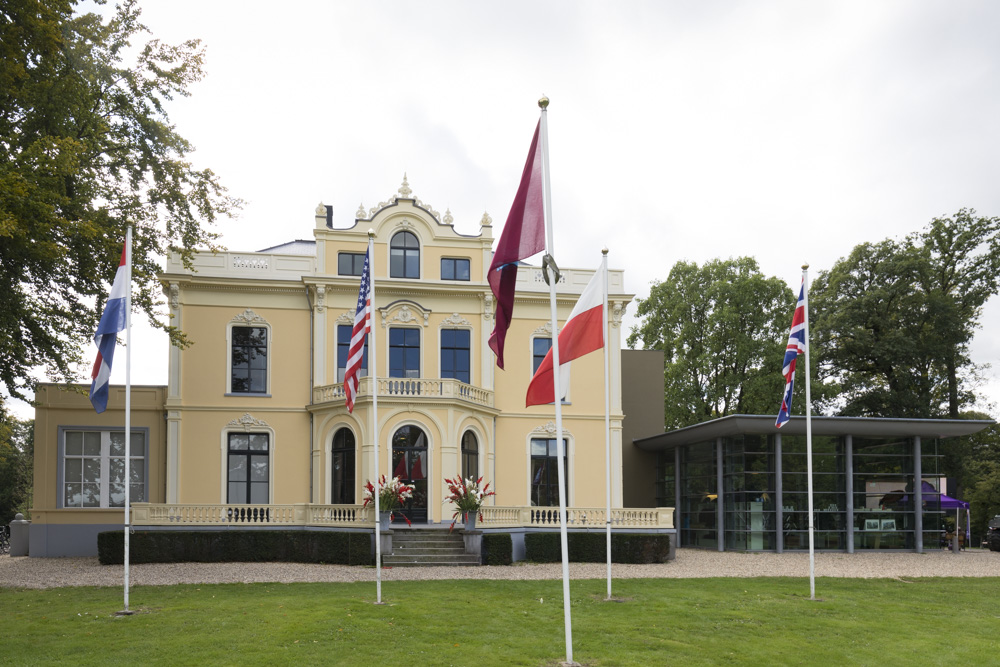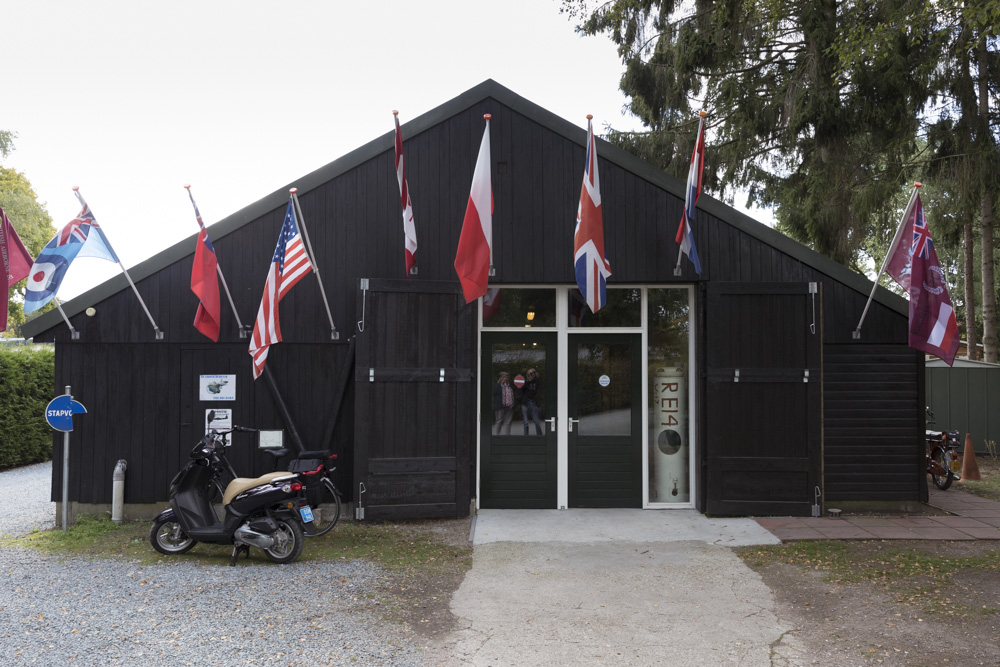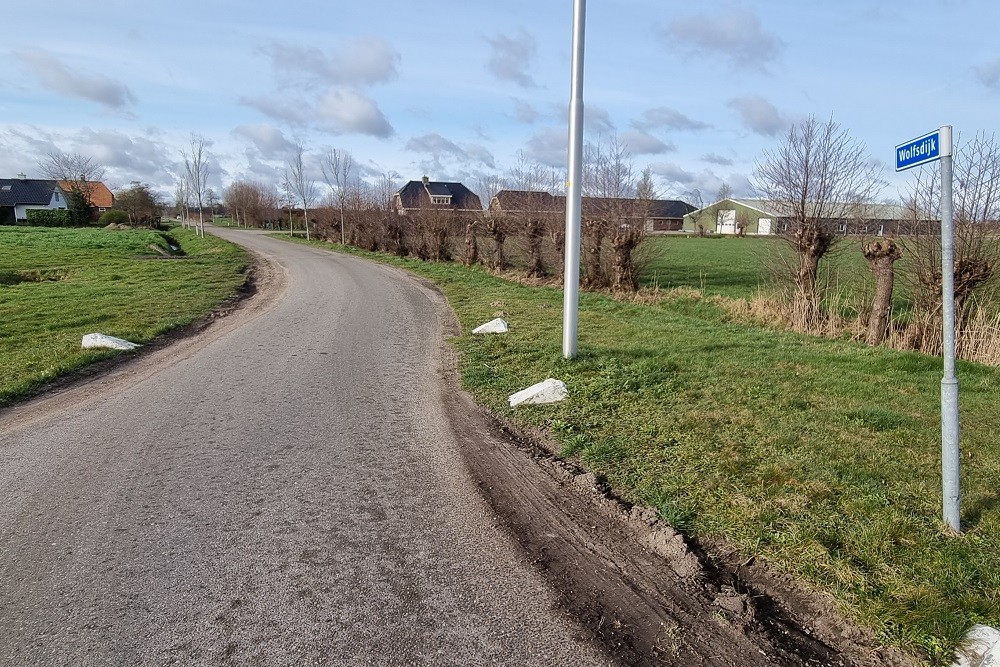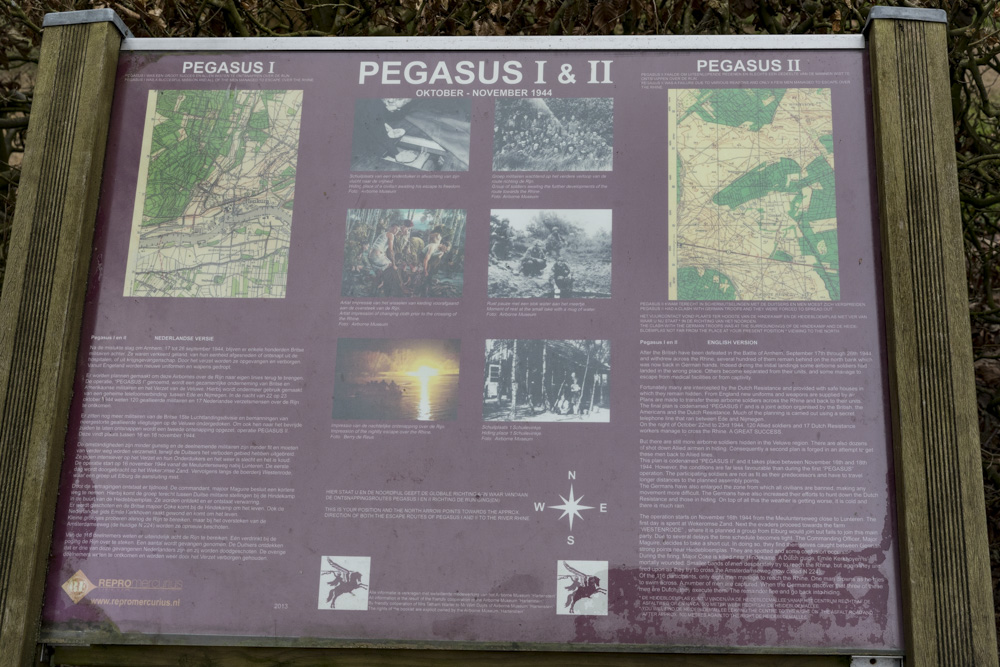Introduction
After the dramatic end of Operation Market Garden, about 300 allied soldiers in the German-occupied territory, north of the Rhine, managed to obviate war captivity by the Germans. These paratroopers (para's) were taken under the wing of the local resistance as much as possible. For various reasons these paratroopers had to cross the river Rhine as soon as possible. In collaboration with the local resistance, the Allies prepared for a mass escape.
On the night of October 22nd to October 23rd 1944 aprox.130 Allied soldiers (about 120 man airborne troops, supplemented by flight crews) and eighteen Dutch civilians from occupied territory succeeded in crossing the Rhine near Renkum. This operation became known as Operation Pegasus 1. According to Major Airey Neave, at that time, as head of the British Military Intelligence (MI9) assigned to "escape and evasion" in Western Europe and therefore partly responsible for the various Pegasus operations, Pegasus 1 was the largest escape from occupied territory during the Second World War.
A few weeks later (November 18th) an attempt was made to take the remaining Allied troops across the Rhine. Again in this escape, local resistance was deeply involved in this escape. This operation turned out to be a big failure, due to several reasons. First the Germans were more alert and next, a large uninhabited area had to be traversed. Only seven out of about hundred soldiers, who participated in Operation Pegasus 2, managed to reach the south bank of the Rhine.
Images
 Insignia of the Britsh air borne troops: a blue Pegasus, ridden by Bellerophon, against a purple background Source: www.wikipedia.org.
Insignia of the Britsh air borne troops: a blue Pegasus, ridden by Bellerophon, against a purple background Source: www.wikipedia.org.Market Garden
The allied troops, which landed in Normandy on June 6th 1944, subsequently advanced rapidly through France. In early September 1944, Brussels and Antwerp had already been liberated and it only took a very short time for the Allies to reach the Belgian-Dutch border. The U.S. commander-in-chief, Dwight Eisenhower, and the British field marshal, Bernard Montgomery, disagreed about how to continue the battle. Eisenhower wanted a broad frontal attack, while Montgomery preferred to advance towards the “IJsselmeer” , through the Netherlands, in order to immediately occupy the Ruhr area.
After fierce discussions between these top soldiers, Montgomery got the approval to develop a plan of attack according to his own philosophy. He devised a bold, immense operation. Three American and British paratrooper divisions were to be dropped near the cities of Eindhoven, Nijmegen and Arnhem. They were to capture the bridges across river Maas, Waal and Lower Rhine and next give the ground forces access to the North German low lands. In this way, mid-September '44, Montgomery as well as Eisenhower saw an opportunity to achieve another decisive victory to the German army and to enforce the capitulation of the German Empire. This operation, called Market Garden, was planned to start on September 17th, 1944
Operation Market Garden did not meet the expectations. Of the 1st British Airborne Division paratroopers, only lieutenant colonel John Frost succeeded in penetrating into the northern approach of the bridge with about 600 men. Due to the heavy resistance, they did not manage to cross the Arnhem road bridge in order to reach the south bank of the river Rhine. On the 18th of September, the connection between the British main forces and their men was already broken at the bridge and all attempts to relieve Frost failed.
On the 20th of September, the British XXX Corps and the American paratrooper divisions captured the bridge at Nijmegen, from the province of Northern Brabant after a tough battle. However, all attempts by the ground forces to reach the Arnhem bridge failed. On September 21st, Frost’s battalion was destroyed and the bridge was permanently in German hands. Meanwhile, the majority of the 1st British Airborne Division had rounded up near Oosterbeek, west of Arnhem. They had to defend themselves in an ever-smaller area and even the deployment of the 1st Polish Airborne Brigade could not stop the fierce German attacks. The vanguard of the XXX Corps had reached the south bank of the Rhine, but were not able to extrude the Germans from their positions in order to cross the river northward.
On the night of September 26th to 27th 1944, defensible paratroopers crawled to the Rhine to be transferred to the south bank by boats. At dawn of September 26th, the evacuation was discontinued, because heavy German fire made it impossible to pursue. Nevertheless, about 2200 British paratroopers returned safely to the liberated area on the south bank of the Rhine. Nearly 8,000 of the approximately 10,000 troops of the 1st British Airborne Division who participated in Operation Market Garden, remained in Oosterbeek. Next to the dead and wounded, approximately 6600 prisoners of war formed part of those who remained. Approximately 300 of those who were left behind, were lucky to escape from German captivity. They sought refuge in the forests around Arnhem and Oosterbeek.
Plan for mass escape
Most soldiers, which went into hiding, were intercepted by the Dutch resistance and housed in the triangle Apeldoorn-Arnhem-Ede. Consequently, the resistance was suddenly facing an enormous task, which required courage, determination and a great ability to improvise, to be executed.
However, Pieter de Kruijff, leader of the "Arnhemse Knokploeg (KP)", a sort of gang fighters, and one of his closest associates, Albert (nickname Wolff) Horstman, had more often faced such challenges in their resistance work. Engineer Pieter de Kruijff worked as a chemist at the "Algemene Kunstzijde Unie" in Arnhem and Albert Horstman worked as an architectural expert at the same company. De Kruijff had gathered eight reliable people around him, who each also managed eight people. This construction minimized the risk of betrayal or mopping up the resistance group.
Each group of the Arnhem KP had a special task. That's how one team was more concerned with helping pilots, while another group was primarily concerned with obtaining and distributing ration cards. Albert Horstman had a special cover for his resistance work, he had founded a transport company with five small trucks. This transport company was allowed by the Germans, because Horstman and his men frequently performed tasks for the Red Cross.
The resistance groups of Pieter de Kruijff from Arnhem and A. (nickname Bill) Wildeboer from Ede were constantly busy providing shelter for fleeing paratroopers, arranging ration cards, food and clothing and manufacturing false identity papers for them.
In the meantime, de Kruijff and his men were already aware of nearly all the addresses where the officers of the staff of the British Brigadier General Lathbury (commander 1st Parachute Brigade of the 1st British Airborne Division) were in hiding. The former staff officers of Lathbury were in hiding not far away from him and every morning they held a staff meeting in the house where the General had found shelter. This was of course dangerous, because the Germans were still were keen on searching for stray and fugitive paratroopers.
Yet this risk had to be accepted, because the paratroopers, who were in hiding everywhere, had to be taken to safety across the river Rhine as soon as possible. The risk of discovery of the various hiding places they used, increased by the hour. Therefore, plans had to be made to take 140 men across the German lines to the banks of the Rhine, as quickly as possible. This dangerous operation could only be performed with the help of the local resistance.
Not all officers agreed upon the resistance group to take the lead in the mass escape, but other officers realized that they would not get far without the support of the resistance. A compromise had to be found because the resistance group was not sufficiently trained to fight against a seasoned enemy. Daily hour-long negotiations took place, often in the presence of the leaders of the local resistance. On topographic maps, suitable places for crossing the Rhine were searched. It was of high importance that, close to each crossing, a rallying point would be available, where the paratroopers would be able to hide during a greater part of the day, in anticipation of the crossing. Finally, it was very important that good agreements were made about accessing the rallying points.
The plan for the mass escape was as follows: the resistance would take the lead in the transportation and take care of the accompaniment of the paratroopers from their hiding places to the rallying point. Also eighteen citizens, with ties to the resistance (Job en Maarten van Bent, Charles Douw van der Krap, Loek Gerards, Thijs den Hertog, Jan Hesseling, Anne Hilbrink, Steef van Keulen, Jan Kooijman, Jan Koster, Rob van der Linden, Bob Mebius, Gerrit Jan Nijhof, Jan de Nooij, Dick Polman, Henk Wienke, Henk van Silfhout en Jan Verschoor), would join them on the way to the liberated south on the other side of the Rhine. The resistance had access to a small arsenal of vehicles, including bicycles, carts and a few small trucks, for the transportation of the paratroopers. Also a large number of guides would be available, to guide the groups of paratroopers through various paths, which could lead to the rallying point. As rallying point, a very dense forest was chosen, in the neighbourhood of Renkum. This forest had been discovered by Maarten van den Bent, a fanatical young resistance fighter, who had a vast knowledge of the terrain of the Veluwe forests.
Then, after days of consultations, the plans were finished, still the approval from the commander of the British Second Army in Nijmegen was needed. By means of a telephone line of the resistance, daily contact with some officers of the staff of the British Second Army was already realized. Also lieutenant colonel David Dobie Theodore swam across the Rhine towards Nijmegen, to have a personal consultation with lieutenant general Sir Miles Dempsey of the British Second Army, in order to secure a successful escape plan. The British Second Army would be responsible for support by means of cover fire, flank protection, sufficient storm boats to transfer the paratroopers and for transportation after the troopers had reached the south side of the river. After extensive discussion, lieutenant general Dempsey approved the plan.
Images
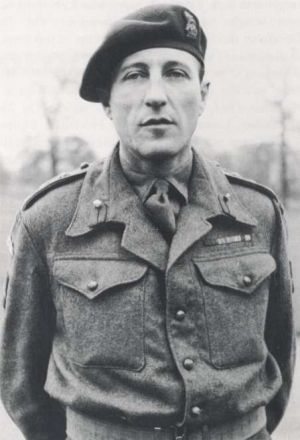 Brigadier general Gerald Lathbury, commander of the 1st Parachute Brigade of the 1st British Airborne Division. He was the highest ranking soldier who participated in Operation Pegasus 1 Source: British Army.
Brigadier general Gerald Lathbury, commander of the 1st Parachute Brigade of the 1st British Airborne Division. He was the highest ranking soldier who participated in Operation Pegasus 1 Source: British Army.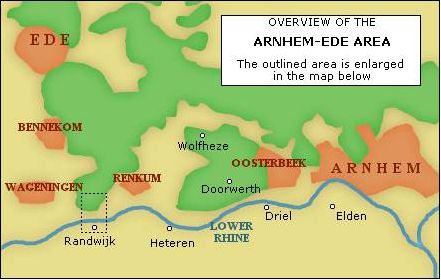 Survey of a part of the escape route form the meeting point to the crossing point Source: www.saak.nl.
Survey of a part of the escape route form the meeting point to the crossing point Source: www.saak.nl.Preparation Pegasus 1
There was still a lot to prepare in a short time. All paratroopers, who were in hiding at various addresses, had to be warned in time and taken to the rallying point near Renkum. Also reconnaissance had to be carried out towards the crossing point, where the short cut ran across the German lines. This crossing was only a few kilometres away from the rallying point. In addition, the escape plan had to be coordinated with the relief troops on the south bank of the river. Finally, additional weapons and uniforms had to be dropped, so the paratroopers, if they would be discovered, could fight their way to the Rhine.
At the last meeting between the staff officers at the hiding place of general Lathbury, the agreement had been made that the escape route to the Rhine would be explored by major Allison Digby Tatham-Warter and a resistance guide. The transport company of Albert Horstman, would fulfil a crucial function during Operation Pegasus 1. He and his men were to transport sixty paratroopers to the rally with two small trucks, provided with gas generators. This was the most risky part of the operation, because these simple cars were not suited for off-road driving. Under leadership of major Tony Hibbert, the largest group of parachutists was brought together in a shelter in Oud Reemst, a small town near Ede.
The technical condition of the two small trucks of Albert Horstman was crucial to the success of Operation Pegasus 1. Two days prior to the start of the mass escape, two mechanics were constantly working on the gas generators of the little trucks, to have them completely in good condition. During the ride to the rallying point, nothing should go wrong with these failure-prone engines.
The leaders of the local resistance group were not allowed to neglect any detail during all preparations. There were one hundred forty lunches to be prepared and to be taken to the rallying point near Renkum. Reliable, patriotic doctors were deployed to medically assist sick and / or injured paratroopers, before they would make the crossing. Next to that, uniforms, weapons and ammunition had to be taken from the storehouses of the local resistance to the rallying point. Boys and girls from the local resistance were committed to guide the paratroopers, as inconspicuous as possible, to the rallying point.
On Friday, the 20th of October, 1944 a German car with a loudspeaker on the roof was driving through the streets of the town of Bennekom. Through the speaker, residents were told to leave Bennekom compulsory before Sunday, October 22nd. No reason was mentioned by the Germans for the forced evacuation, but the message led to great confusion and anxiety among the villagers. However, for a small group this German order was if it had been sent for. On October 21st and 22nd, due to this evacuation, roads would be very crowded, causing the Germans being unable to check the big flow of people. Local resistance considered this to be an excellent opportunity and therefore did not hesitate to make use of it. Due to this all, Operation Pegasus 1 had to be antedated by one day, which put extra strain on the improvisation abilities of the resistance.
Pieter de Kruijff and Albert Horstman decided to use trucks of the transport company, provided with the Red Cross logo, for Operation Pegasus 1. With these trucks it would be possible to transport a large group of paratroopers in one time, in a rather inconspicuous manner. In addition, the resistance would have more time and manpower available to guide other paratroopers to the rallying point near Renkum. A difficulty was that the trucks of the Red Cross, according the Geneva Conventions, were not allowed to be used for the transportation of armed paratroopers. Horstman and De Kruijff decided to assign two members of the resistance group of Horstman to be the drivers of the trucks. These two resistance men were not to know what the real purpose of the trip would be. During the trip, the two trucks would be 'raided' by the resistance near the village of Oud Reemst. This was close to where about fifty paratroopers were hiding and who then rapidly could jump into the trucks. Every few miles, female couriers would be standing along the road with a bicycle in their hand. If everything would be OK, they would be standing in the longitudinal direction of the road. However, if something would be wrong, they would stand across the road and pretend to repair their bicycle.
Images
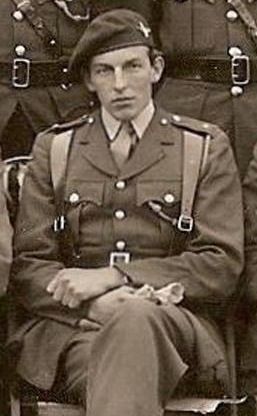 Major Digby Tatham Warter was one of the leading personalities during Pegasus 1 Source: British Army.
Major Digby Tatham Warter was one of the leading personalities during Pegasus 1 Source: British Army.Operation Pegasus 1
The group of paratroopers, which was gathered in Ede, would be taken to the rallying point near Renkum by bicycle, in groups of five and under the supervision of guides. On October 22nd, 1944 at half past ten in the morning, the first groups left and around twelve the last five paratroopers. Albert Horstman kept a tight schedule for his part in Operation Pegasus 1, namely the transport of sixty paratroopers in two small Red Cross trucks. On that same day, at quarter past five in the evening, the generators were started in order to warm up and at half past five, these trucks would leave. From six o’clock the paratroopers were to be ready and waiting, armed and dressed in uniform, at the cabin in Oud Reemst in order to get in the trucks as quickly as possible.
When around half past seven, the two trucks drove along the refuge in Oud Reemst, they were "attacked" by two members of the resistance. The two drivers who had not been informed about the operation, were not convinced immediately, whether they could join the transport of the armed paratroopers. This was, as mentioned, contrary to the Geneva Conventions. After some discussion with Horstman, the two drivers decided to participate. During a possible arrest by the Germans, the two drivers could state that they were attacked by the resistance group.
Meanwhile, the sixty paratroopers from the shelter at Oud Reemst arrived at the trucks. The men had to lie upon each other in two layers, due to the limited loading space. Also they all had to keep their weapons at hand in order to defend themselves in case of an emergency. It took quite some effort to get everyone into the trucks, but after fifteen minutes both trucks, with their heavy human load, came into motion. The trucks could not drive too hard, because the gas generators had a limited power output.
Horstman had decided to take a detour with the trucks, through Otterlo. Actually, doing so, they would get into the flow of evacuees from Bennekom and thus would be less noticeable. From Otterlo they would be assisted by the female couriers, who were standing along the road, every few miles, with their bikes in the longitudinal direction. Everything went well until just before the end of the ride. Here they ran the greatest risk, because the rallying place was at a few hundred meters from a German artillery position. A few hundred meters before the rally at Renkum, two German soldiers ordered the trucks to stop. At the command of Horstman, the two drivers ignored the German order and drove on. Luckily the Germans took no action. The reason for this has never been known, but if the Germans would have investigated this, Operation Pegasus 1 would, most likely, have failed. At nine o'clock the long procession of 148 men (130 soldiers and 18 civilians) headed for the Rhine. The guide, the resistance member Maarten van den Bent, who knew the South Veluwe very well, led the way. It was pitch dark, which made the procession to proceed at a slow pace. One kept in touch by putting the hand on the shoulder of the predecessor. Major Digby Tatham-Warter and Maarten van den Bent had calculated that, under these circumstances, the group would need three hours to reach the Rhine. At twelve o'clock sharp, the storm boat team had to be contacted.
Around eleven Maarten van den Bent stepped out of the dense forest and stopped at the large barn of resistance member Jan Peelen. From here the paratroopers took over the leadership from the resistance and the situation turned into a military operation with scouts in front and flank and rear security. The most dangerous part of the journey then had to be made: the paratroopers had to crawl in between two German positions. Every half hour, the Germans sent out a patrol unit into the field, to make contact with the two posts. Preceded by guide Jan Peelen, the escapees, crawled very cautiously between the two German positions and fortunately they were not discovered. About twelve o’clock, the 148 man safely reached the banks of the Rhine. After waiting some time, a large outburst of artillery took place at the opposite side of the river. In the west, tracer ammunition went into the air with a big arch to extinguish shortly afterwards . That was the prearranged signal from the U.S. 101st Airborne Division. In Morse code, major Tatham-Warter quickly telegraphed three times the letter K and he repeated this every few minutes. Within twenty minutes, all 130 allied soldiers and 18 civilians with ties to the resistance, were transferred by means of storm boats. Operation Pegasus 1, one of the most spectacular and successful mass escapes in the Second World War, came to an end.
Images
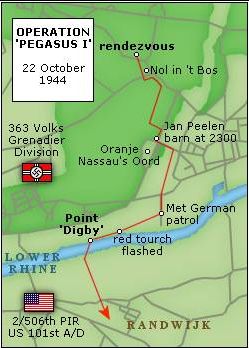 Survey of a part of the escape route form the meeting point to the crossing point Source: www.saak.nl.
Survey of a part of the escape route form the meeting point to the crossing point Source: www.saak.nl.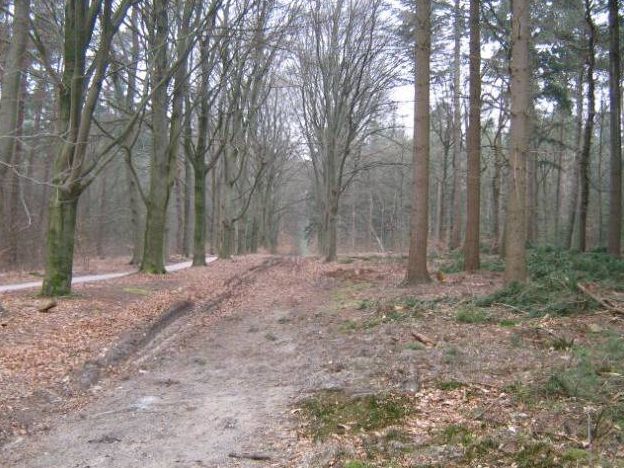 Under the guidance of resistance fighters, the paratroopers crossed these woods near Renkum, on theri way to the Rhine Source: www.saak.nl.
Under the guidance of resistance fighters, the paratroopers crossed these woods near Renkum, on theri way to the Rhine Source: www.saak.nl.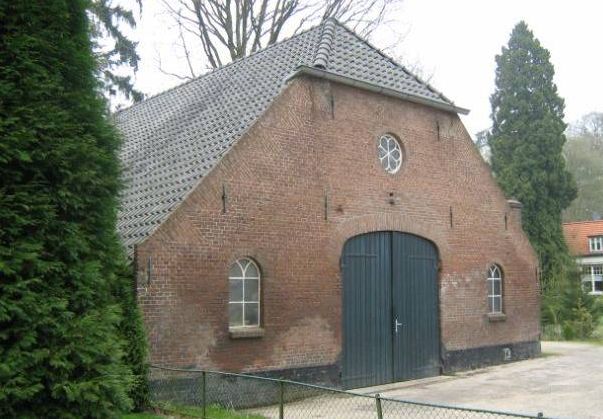 This barn was the last stop before the river Rhine was reached Source: www.saak.nl.
This barn was the last stop before the river Rhine was reached Source: www.saak.nl.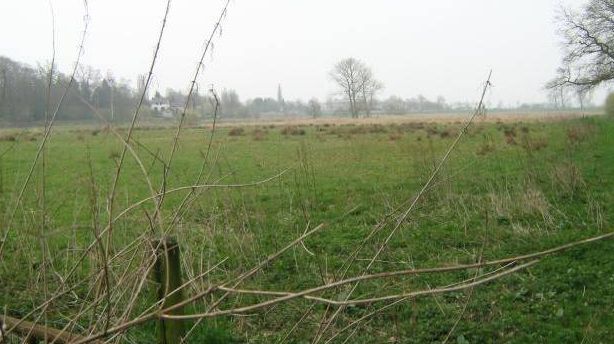 The paratroopers had to cross this open area, where the Germans patrolled regularly, for the last hundred meters, to reach the Rhine Source: www.saak.nl.
The paratroopers had to cross this open area, where the Germans patrolled regularly, for the last hundred meters, to reach the Rhine Source: www.saak.nl.Aftermath
Pegasus 1 was a great success and arose much interest during and after the war. Several books have been published about this operation and many soldiers and civilians, who were involved in this operation, received an award for their contribution. About Pegasus 2, the second escape attempt that failed, much less is known.
After Pegasus 1, about 150 British paratroopers still remained, who for various reasons, had not been able to join at Pegasus 1. The Germans had also taken note of the great success of Pegasus 1, which got a lot of attention of the British media. The Germans were furious about letting go of such a big loot. Therefore, they decided, by any means, to prevent the remaining paratroopers from escaping. There were frequent patrols and the Rhine was heavily guarded.
Yet there was an attempt to transfer the remaining Allies over the Rhine. On November 18th, a group of about 100 paratroopers was on their way to the Rhine to make a crossing. Very early, they met a German patrol, which caused the procession of refugees to fall apart. Seven out of the approximately 100 men who participated in Pegasus 2, managed to make the crossing. About 30 men were captured and about 50 men escaped from German hands.
Information
- Translated by:
- Chrit Houben
- Published on:
- 17-10-2012
- Last edit on:
- 30-09-2024
- Feedback?
- Send it!

